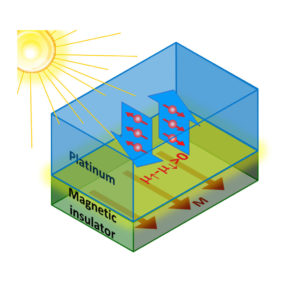The light stuff: A brand-new way to produce electron spin currents
 A schematic of the CSU team’s device that
demonstrates using
A schematic of the CSU team’s device that
demonstrates usinglight to create a spin current. A spin voltage drives spin-up and
spin-down electrons to move in opposite directions, resulting in
a pure spin current across a platinum layer.
(05/01/2016) - With apologies to Isaac Asimov, the most exciting phrase to hear in science isn’t “Eureka,” but “That’s funny…”
A “that’s funny” moment in a Colorado State University physics lab has led to a fundamental discovery that could play a key role in next-generation microelectronics. Publishing in Nature Physics April 25, the scientists led by Mingzhong Wu, professor of physics in CSU’s College of Natural Sciences, are the first to demonstrate using non-polarized light to produce what’s called a spin voltage – a unit of power produced from the quantum spinning of an individual electron. Controlling electron spins for use in memory and logic applications is a relatively new field called spin electronics, or spintronics, and the subject of the 2007 Nobel Prize in Physics. Read More.


